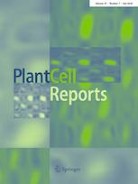Ver ítem
- xmlui.general.dspace_homeCentros e Institutos de InvestigaciónCICVyA. Centro de Investigación en Ciencias Veterinarias y AgronómicasInstituto de BiotecnologíaArtículos científicosxmlui.ArtifactBrowser.ItemViewer.trail
- Inicio
- Centros e Institutos de Investigación
- CICVyA. Centro de Investigación en Ciencias Veterinarias y Agronómicas
- Instituto de Biotecnología
- Artículos científicos
- Ver ítem
Generation of a multi‑herbicide‑tolerant alfalfa by using base editing
Resumen
We present the first report on base editing in alfalfa. Specifically, we showed edited alfalfa with tolerance to both sulfonylurea- and imidazolinone-type herbicides. Alfalfa (Medicago sativa) is one of the most important forage legumes worldwide. However, alfalfa-breeding programs are limited by the particular reproductive features of the species itself. Cultivated alfalfa is an allogamous perennial polyploid species that exhibits high levels of
[ver mas...]
We present the first report on base editing in alfalfa. Specifically, we showed edited alfalfa with tolerance to both sulfonylurea- and imidazolinone-type herbicides. Alfalfa (Medicago sativa) is one of the most important forage legumes worldwide. However, alfalfa-breeding programs are limited by the particular reproductive features of the species itself. Cultivated alfalfa is an allogamous perennial polyploid species that exhibits high levels of self-incompatibility and strong inbreeding depression (Dieterich Mabin et al. 2021). Consequently, the rapid and inexpensive introgression of both transgenes and edited alleles into elite alfalfa germplasm requires the use of dominant traits (Bottero et al. 2021; Jozefkowicz et al. 2018). In this context, the commercial application of full knockout of recessive genes in alfalfa efficiently generated via the CRISPR/Cas9 system (Bottero et al. 2021; Chen et al. 2020; Wolabu et al. 2020).
[Cerrar]

Autor
Bottero, Ana Emilia;
Gomez, Maria Cristina;
Stritzler, Margarita;
Tajima, Hiromi;
Frare, Romina Alejandra;
Pascuan, Cecilia Gabriela;
Blumwald, Eduardo;
Ayub, Nicolás Daniel;
Soto, Gabriela Cynthia;
Fuente
Plant Cell Reports 41 (2) : 493-495 (Febrero 2022)
Fecha
2022-02
Editorial
Springer
ISSN
1432-203X
Documentos Relacionados
Formato
pdf
Tipo de documento
artículo
Proyectos
(ver más)
INTA/2019-PE-E6-I115-001/2019-PE-E6-I115-001/AR./Edición génica, transgénesis y mutagénesis como generadores de nueva variabilidad en especies de interés agropecuario
Palabras Claves
Derechos de acceso
Restringido
 Excepto donde se diga explicitamente, este item se publica bajo la siguiente descripción: Creative Commons Attribution-NonCommercial-ShareAlike 2.5 Unported (CC BY-NC-SA 2.5)
Excepto donde se diga explicitamente, este item se publica bajo la siguiente descripción: Creative Commons Attribution-NonCommercial-ShareAlike 2.5 Unported (CC BY-NC-SA 2.5)

